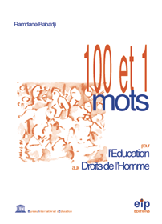

Today, action in the domain of human rights is the outcome of both a feeling of necessity as well as the desire to help build a world that is more equitable, fair and friendly. Faced with globalization, social change and new challenges in the relations between different generations and communities, schools and teachers have the obligation and responsibility to help children and adolescents learn to live together. They must develop this desire, which constitutes one of the basic pillars of human rights : the impetus to want to live together and the knowledge of how to do so.
One hundred and one terms, that is the content of the publication we propose to you. Over and above the normal purpose of a glossary, the one hundred and one selected terms tell a story : that of human rights. It is told in such a way that the teachers for whom it is destined can then tell it, in their own way, to the children and adolescents in their charge.
More than a simple story that sets out the basics and principles of the past, the history of human rights is a point of departure to guide us into the history of tomorrow, that which we are building today. It is here and now that our influence will be decisive in creating the world to come.
This glossary will, therefore, allow each of it users – teacher, students and all who commit to do so – to unfold the story according to their concerns. Each can start with the entry of their choice and, for example, plunge into the world of human rights protection institutions by looking at the various committees, commissions, councils, courts, etc. Or, it is possible to look at issues concerning education as seen from the human rights viewpoint. The reader will also have the opportunity to familiarize him/herself with the legal language of treaties, declarations, submissions and appeals.
Whichever approach is taken, the most important is to remember that these terms are the pillars on which we must build our future, starting with “Adherence” and finishing with the integration of “Universal” values. These values are stipulated in the Universal Declaration of Human Rights, adopted by the United Nations General Assembly on 10 December 1948. This Declaration also includes a right that is the primary concern of both the International Bureau of Education and the World Association for the School as an Instrument of Peace. Often neglected, this right nevertheless occupies a central place in human rights : remember that through the Committee on Economic, Social and Cultural Rights the right to education affects the indivisibility and the interdependence of all human rights and that education is both a fundamental right in itself as well as a key to the other rights inherent to human beings.
By working together to publish this glossary, the IBE and EIP want to contribute not only to the implementation of the right to education, but also to provide a tool for human rights education.
Cecilia Braslavsky Monique Prindezis
Director Secretary General
International Bureau of Education World Association for the School
as an Instrument of Peace
